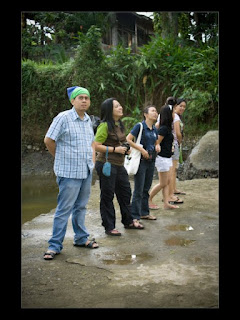I've met a few of these true-blue twitchers over the years that I've been birding in the Philippines. They were expats--mostly Brits, but there was also a Dutch dude. A couple of them were in the bird tour business, which technically means they get paid to twitch.
You can tell they're twitchers because they don't mind spending a lot of money to go to remote places--usually without good roads or sleeping facilities or bathrooms--all for just a split-second glimpse of some bird. Of course, for the bird tour dudes, the motivation may have been partly business.
I admire the commitment of twitchers. They don't mind not bathing, or eating full meals, or even talking to another living soul--for days at a time--while they stake out their target species. It seems that the rarer the bird, the more ridiculous the lengths they would go.
Dude birding
Meanwhile, a lot of the birders I've met in the Philippines are 'dude-birders,' or those who watch birds because they're simply fascinated with them. They would rather bird in the shade, or some spot where they can have coffee or beer, than stake out under the tropical sun or in a mosquito-infested forest. Consequently, they rarely see something rare or new, which is fine with them, because they also don't tire of seeing the same common birds all the time.
As a casual birder, I'm more of a dude-birder than a twitcher. I don't really keep a list, but I can easily pick out which species in the Kennedy field guide to Philippine birds I haven't seen before (half of them, actually!).
I do go to places where particular species I haven't seen before are reported by other birders, but only if these places are accessible and don't require days of camping out. When I visit a new place, I make sure I bring my bins and keep a mental note of what species to look out for.
So when I was in Batanes last June, I made sure I ticked off the Japanese Paradise-flycatcher and the Brown-eared Bulbul, both of which can only be found on those parts of the country, albeit they're very common there. When I was in Laoag December last year, I made sure I visited the city's Chinese Cemetery where the migrant Silky Starlings have been reported, so I could tick those off, too.
 I saw the Japanese Paradise-flycatcher at a church right across
I saw the Japanese Paradise-flycatcher at a church right acrossthis small cafe in Batanes
 At a lovely lighthouse in Ilocos, just a few minutes from Laoag
At a lovely lighthouse in Ilocos, just a few minutes from Laoagwhere I earlier saw a flock of Silky Starlings
But when I go home to Iloilo, I never bother to go up the hinterlands of Panay in search of the critically-endangered Warden's Hornbill, which is what a committed twitcher would do. It's not so much the distance or the travel time that I mind, but the poor odds of actually seeing the bird. The more endangered birds are, the more difficult they are to find, because there are so few of them left in the wild. So chances are, the hours of hiking up the mountains of Central Panay, and camping out if there are no homestay options available, will be for nothing.
Competitive birding
But not so for most twitchers. A glimpse is all they need. And then the bird gets boring. Or they may want to see it again, but for next year's tick list. That's because twitching is usually less about the birds than about competition. You compete with other twitchers, or with last year's tick list.
I came across two articles (see below) about the seemingly innocuous world of twitching, and how when taken to the extreme it can break up marriages, ruin friendships, and skew up people's perspective of life. It was after reading these articles that I thought of writing this blog entry.
The first one is from 2008, so it's somewhat old news. It's about Adrian Riley who went twitching-crazy in 2002 and wrote a book about how it ruined his life.
The bird brains: the dark and dishonest world of twitchers
By GEOFFREY WANSELL
10 January 2008
The second one is a reflection of an ex-twitcher, now a casual birdwatcher, on twitching, which was featured in the recent BBC documentary 'Twitchers: A Very British Obsession,' aired last week I think. I haven't seen it yet (I don't know when it will be available on my side of the globe), but based on reactions I've read online, it has apparently exposed the ugly side of birding when it becomes a competitive obsession.



No comments:
Post a Comment